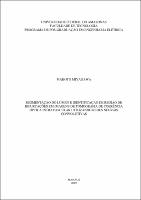| ???jsp.display-item.social.title??? |


|
Please use this identifier to cite or link to this item:
https://tede.ufam.edu.br/handle/tede/6967Full metadata record
| DC Field | Value | Language |
|---|---|---|
| dc.creator | Miyagawa, Makoto | - |
| dc.creator.Lattes | http://lattes.cnpq.br/7692742443591984 | por |
| dc.contributor.advisor1 | Costa Filho, Cícero Ferreira Fernandes | - |
| dc.contributor.advisor1Lattes | http://lattes.cnpq.br/3029011770761387 | por |
| dc.contributor.advisor-co1 | Costa, Marly Guimarães Ferreira | - |
| dc.contributor.advisor-co1Lattes | http://lattes.cnpq.br/7169358412541736 | por |
| dc.contributor.referee1 | Gutierrez, Marco Antônio | - |
| dc.contributor.referee1Lattes | http://lattes.cnpq.br/4428534123137232 | por |
| dc.contributor.referee2 | Pereira, José Raimundo Gomes | - |
| dc.contributor.referee2Lattes | http://lattes.cnpq.br/3697983438100904 | por |
| dc.date.issued | 2019-01-30 | - |
| dc.identifier.citation | MIYAGAWA, Makoto. Segmentação do lúmen e identificação de região de bifurcações em imagens de tomografia por coerência óptica intravascular utilizando redes neurais convolutivas. 2019. 82 f. Dissertação (Mestrado em Engenharia Elétrica) - Faculdade de Tecnologia, Universidade Federal do Amazonas, Manaus, 2019. | por |
| dc.identifier.uri | https://tede.ufam.edu.br/handle/tede/6967 | - |
| dc.description.resumo | A utilização da tomografia por coerência óptica intravascular (IVOCT) permite que especialistas possam avaliar lesões coronarianas em alta resolução. A automatização de algumas etapas da análise poderia beneficiá-los, uma vez que a análise visual dos frames em um pullback é trabalhosa e consome muito tempo. Mesmo com a crescente popularidade das redes neurais convolutivas (CNN) na área médica, ainda há poucos trabalhos aplicados a imagens IVOCT para segmentação do lúmen e classificação de região de bifurcação. Neste trabalho, avaliamos três arquiteturas de CNN para a tarefa de segmentação do lúmen e quatro arquiteturas para a tarefa de classificação de região de bifurcação, utilizando um conjunto de imagens IVOCT de nove pullbacks de nove diferentes pacientes. Em relação à segmentação do lúmen, foram avaliadas redes diretas e de grafos acíclicos direcionados (DAG) em diferentes bases de dados, variando a resolução espacial, sistema de coordenadas e espaço de cores. Em relação à classificação de região de bifurcação, além das variações em sistema de coordenadas e espaço de cores nas bases de dados, foram utilizadas técnicas de data augmentation para balanceá-las, de forma a compensar a menor quantidade de imagens de bifurcação, além de utilizar transferência de conhecimento em algumas das redes avaliadas, aplicando a aprendizagem originada de uma das redes de segmentação. Nossos resultados são comparáveis aos outros trabalhos encontrados na literatura, apresentando, para a segmentação, melhores resultados em acurácia, coeficiente Dice e Jaccard acima de 99%, 98% e 97%, respectivamente. Na classificação, apresentou melhores resultados em score F1 (99,68%) e AUC (99,72%) obtidos por uma rede CNN com conhecimento transferido. | por |
| dc.description.abstract | Intravascular Optical Coherence Tomography (IVOCT) technology enables the experts to analyze coronary lesions from high-resolution images. Some level of automation could benefit experts since visual analysis of pullback frames is a laborious and time-consuming task. Even with the growing popularity of Convolutional Neural Networks (CNN) in the medical area, there are few works in the literature applying them to lumen segmentation and classification of bifurcation regions tasks. In this work, we evaluated three CNN architectures for the lumen segmentation task, and four architectures for bifurcation region classification, using an IVOCT image set of nine pullbacks from nine different patients. Regarding lumen segmentation task, direct networks and direct acyclic graph (DAG) networks were evaluated in different datasets, varying spatial resolution, coordinate systems, and color space. Regarding bifurcation region classification, besides variations in the coordinate systems and color space of the datasets, data augmentation techniques were used to balance them, in order to compensate for the smaller number of bifurcation images, besides using transfer learning in some of the evaluated networks, applying knowledge acquired from one of the segmentation networks. Our results are comparable to the other works found in the literature, presenting, for segmentation, best results in accuracy, Dice coefficient, and Jaccard over 99%, 98%, and 97%, respectively. In classification, better results were presented in F1 score (99,68%), and AUC (99,72%) obtained by a CNN with transferred knowledge. | eng |
| dc.format | application/pdf | * |
| dc.thumbnail.url | https://tede.ufam.edu.br//retrieve/28414/Disserta%c3%a7%c3%a3o_MakotoMiyagawa_PPGEE.pdf.jpg | * |
| dc.language | por | por |
| dc.publisher | Universidade Federal do Amazonas | por |
| dc.publisher.department | Faculdade de Tecnologia | por |
| dc.publisher.country | Brasil | por |
| dc.publisher.initials | UFAM | por |
| dc.publisher.program | Programa de Pós-graduação em Engenharia Elétrica | por |
| dc.rights | Acesso Aberto | por |
| dc.subject | Doenças cardiovasculares | por |
| dc.subject | Tomografia por coerência óptica intravascular | por |
| dc.subject | Redes neurais convolutivas | por |
| dc.subject | Transferência de aprendizado | por |
| dc.subject | Segmentação do lúmen | por |
| dc.subject | Detecção de bifurcação | por |
| dc.subject.cnpq | ENGENHARIAS: ENGENHARIA ELÉTRICA | por |
| dc.title | Segmentação do lúmen e identificação de região de bifurcações em imagens de tomografia por coerência óptica intravascular utilizando redes neurais convolutivas | por |
| dc.title.alternative | Lumen segmentation and identification of bifurcation region in intravascular optical coherence tomography images using convolutional neural networks | eng |
| dc.type | Dissertação | por |
| Appears in Collections: | Mestrado em Engenharia Elétrica | |
Files in This Item:
| File | Description | Size | Format | |
|---|---|---|---|---|
| Dissertação_MakotoMiyagawa_PPGEE.pdf | 5.14 MB | Adobe PDF |  Download/Open Preview |
Items in DSpace are protected by copyright, with all rights reserved, unless otherwise indicated.




